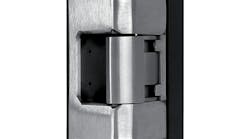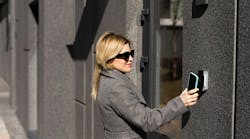Depending on your role as a locksmith, a systems integrator, a consultant, or a manufacturer, the phrase “high security” conjures up something different for everybody, from physical security and patented keyways to cybersecurity to everything in between. One can’t just talk about physical security without mentioning electronic, cyber or IT security, as many systems are no longer just siloed but are connecting to and communicating with each other or with a larger security operations center, or a software platform.
While the focus of this article is on the latest trends in fortifying the most vulnerable doors and entry points to a building, the conversation invariably takes us into the world beyond impenetrable doors, locks, barriers and other deterrents to areas such as clone-proof prox cards, readers and mobile credentials.
Protecting Against Forced Entry
“People use the phrase ‘high security,’ but everybody forgets about using the term ‘protecting against forced entry’ because high security could be manipulation of the key, or it could be all sorts of things,” says Mark Berger, president of Securitech, which was recently acquired by ASSA ABLOY. “There are too many meanings, but we like to focus on protecting against that guy with a crowbar, or with any tools they are going to use to try to break in. So anytime someone uses the term high security, I always ask, ‘what are they talking about?’”
Berger points out that he is seeing increases in forced entry attempts. “We say attempts because we get pictures from our dealers who are happy campers because the criminals didn't break through our doors,” says Berger. “We've got pictures of them breaking through walls next to our locks, protected with our doors.”
He continues, “The number one goal of any forced entry product is to send someone to your neighbor. A thief is going to find the easiest door to break through. Burglars do not like to work hard; if they wanted to work hard, they wouldn't be burglars, right? You just want to be a little bit harder to break into than your neighbors.”
For businesses concerned with protecting high-value merchandise, such as cell phone stores, and cannabis dispensaries, Berger says criminals are most likely going to try and get into both the back door and interior storage room.
“Our area of expertise, of course, is protecting the high value items in that retail space, and we're seeing a lot more brazen attempts for people to try to break through back doors,” notes Berger. “And then when folks drop into the ceiling or break into the building next door, we see people are doing a better at job securing that interior storage area, whether it's fortifying the walls, fortifying the ceiling, putting the protective door on the storage area … giving themselves an extra 10-15 minutes for that law enforcement response to come, and that is our area, helping those folks.”
Growing Verticals
One area that Berger has seen the most growth, no pun intended, is in protecting cannabis facilities.
“Cannabis is probably our fastest growing market across the country, so we've been working with the individual dispensaries across the country and the MSOs, which are the multi-state operators, and we've got a whole bunch of them that specify our products. And in some states, they've mandated a higher level of forced-entry protection. What we've seen from the MSOs is that once they're mandated in a certain state, they're using us. And many times, now when they go into other states, they don't even wait for a mandate – they just put us into their base specifications and we're protecting their rear doors for logical reasons.”
Protecting critical infrastructure is also becoming a priority and not just access control and keys, notes Berger, but for forced entry as well. Other areas for forced entry include utility buildings, standalone government buildings, cell sites, data centers, etc., he says.
“What you want to do is make so they have to destroy the door to be able to go into a building,” Berger explains. “Because if the door is seen as being violated, somebody doesn't want to be inside doing something – they want to get past an easy lock, close the door behind them so that they're not observed.”
Berger is also seeing within the government world a move toward providing a level of mechanical lockout. “We do a keyed high security lockout of doors that are access controlled. But it is essential to maintain code-compliant single-motion egress from the interior side. So, it's not like adding a secondary lock on the door. We do it all tied into one, maintaining code-compliance while providing high security lockout functionality.”
Life Safety Focus
As Berger points out, whether it is a high security government building or a school, it is important to look at both security and convenience with life safety as the overall driving factor in any security decision.
“That's critical to remember – you cannot sacrifice life safety when you're putting in high-security methods. The big part here that I want to emphasize is that as you move toward more high security, don't just listen to the people that I respectfully call the ‘wire runners,’ and the systems integration community and the electronic security consultant because they are not always familiar with door life safety codes,” notes Berger. “And you must make sure that you never sacrifice one for the other. So, it's very important to get that out there because you never want to put anyone in harm's way. I always say that the most secure buildings in the world were those two buildings that used to be in lower Manhattan, but they were also the safest with easy egress, which saved many lives.”
Berger explains that there are three elements to any security decision: safety, security, and convenience, which “is understanding the user and how they're going to use the space. If you combine all three together, you've developed an intelligent solution. If you leave anyone out, you're going to have a life safety problem, a security problem, or both.”
Beefing up Door Hardware
Looking closer at door hardware, such as strikes and locks, Camden Door Controls Project Manager David Ito is seeing a trend for products that meet higher standards and specifications.
“We're seeing that people are finding that what would typically be okay for a grade two lock, now they're looking at securing the door with the grade one,” explains Ito. “They're also asking for a lot more UL certification on the door hardware, including it being fire rated. So, we've been pushing to make sure all our future door hardware is going to meet these requirements, including UL 94, so you'll see a lot more of that. We already have products that meet these specifications, but we have a whole new line of door hardware that we're going to be releasing soon, and one of the mandates is to make sure that it’s UL-rated, code-compliant and fire rated.”
Ito adds that people are also asking for more information about the holding force of the door hardware. “It is not only about meeting the life safety and fire requirements, but also meeting the building, property, or the business owner requirements of trying to deter theft. And you also need to look at things like delayed egress, which is becoming very popular but is a whole different type of door hardware.”
He continues, “We want to provide more options for door control and door hardware, including the perimeter, so the new outdoor rated door strikes coming out and the middle box are based on that feedback from locksmiths so they can weld that up to the middle gates and add another layer of security beyond the actual door to the building.”
Smarter Cards and Mobile Credentials
Looking at the evolution of door hardware and devices that populate the door – including smarter and more secure proximity cards and readers as well as the proliferation of mobile access – Ito and his team have been busy creating smarter and more secure solutions for their customers. Looking at proximity cards, for example, which have been prevalent for decades, Ito points out that the older technology that existed in these cards was easily cloned. “And that really is a detriment to the security industry because now you have a card that is supposed to identify Tom Smith, and now you’ve really got 12 Tom Smiths coming through that door.”
He continues, “What they've been asking us as manufacturers is to migrate away from that and start going to a more secure credential, so we created a card, a credential that uses a higher and more secure frequency, which makes it much more difficult for the public to clone. And we introduced a card reader that has a high level of – and new protocols for – protection against cloning.”
Ito says cloning is one of the most frequent questions they get about prox cards. “That is the basic question, and they just want a ‘yes or no,’ answer – they are not interested in knowing about the technology in the background. So rather than providing extensive training for the sales team, we came up with what we call cheat sheets, which have the products we offer, and lists all the card readers and the different credentials and technologies … and all the technical terms in there that may be discussed.”
With the growth of the multi-housing market, including condos and apartment buildings, “they're looking for cost effective yet secure solutions,” says Ito. “With this type of reader, they can use a smartphone as a credential, which also can offset the cost, so they're not paying for another card or another new device to activate or work with the card reader. They can use their existing smartphone and just download an app for free.”
Another key area of focus for the company, he says, is making sure that all devices are compatible with other systems in the industry. “When a locksmith puts our product on the door, he knows this is going to be compatible with what's already in the building, or with what the owner thinks they're going to put in their building in the future.”
Future of the Industry
As we look to what 2024 holds for us, both Berger and Ito are confident that the security industry will continue to flourish.
“I think it's a great time – a golden era for the security industry, for the physical security industry and for the mechanical locking industry and all the door hardware elements,” says Berger. “The best thing about this industry now is that we have just a handful of major players – and obviously now I am part of one of them – so it is great for consumers because you're going to continuously see product improvements because each one is trying to outdo the others in certain areas.”
Ito adds, “We’re optimistic. What I've learned from my time in security is that even when the economy is bad, security still does very well. With increases in crime and theft during uncertain times, for example, everybody wants to protect their well-being and their assets. So, we're finding that anything related to the security realm has been doing well and continues to do well.”









